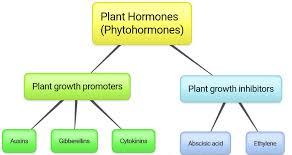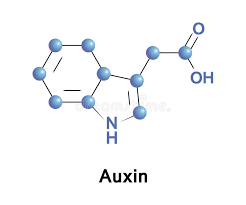PLANT HORMONES- TYPES & EFFECTS
DEFINITION
Plant hormones are chemicals naturally produced in plants that in small amounts promote and influence the growth, development, and differentiation of cells and tissues.
These are most important biochemical affecting plant growth and yield under different condition and stress too. Thimann used the term Phytohormone for plant hormones.
IMPORTANT POINTS
- Generally, the production of hormones occurs at sites of active growth within the meristems before cells have fully differentiated. After production, they are translocated to other parts of the plant, where they can cause an immediate effect; or they can be stored in cells to be released later.
- Plants use different pathways to regulate internal hormone quantities and moderate their effects. Plants can also break down hormones chemically, effectively destroying them.
- Plant functioning under stress condition is affected by plant hormones, which can help the plant to tolerate the environmental stresses. Plant hormone plays an important role as a signaling molecule and induces various plant stress responses in the perception, transduction, and induction phases of the stress response.
- The concentration of hormones required for plant responses are very low (10−6 to 10−5 mol/L).
Plant hormones include–
- Auxin
- Abscisic acid
- Ethylene
- Gibberellins
- Cytokinins
- Salicylic acid
- Strigolactones
- Brassinosteroids and
- Nitrous (nitric) oxide.
Growth Hormones
These are such organic substances which are produced generally in meristematic tissues of the plant and trans-located towards the site of action inducing physiological process and can work in minute quantities.
Plant Growth Regulator (PGR)
A large number of chemical compounds (other than nutrients) are synthesized by humans to regulate the growth of cultivated plants, weeds, and plant cells, known as PGR. PGR occurs naturally in plants as well as synthetic. They have ability to promote, inhibit or modify any physiological processes even in small amounts.
Generally PGR is of two types –
- Growth Promoter- Auxin, Gibberellins, Cytokinin/kinetin/kinin
- Growth Inhibitor- Abscisic acid, Ethylene

AUXIN
Indole acetic acid (IAA) occurs naturally in plants, while synthetic auxins are Indole-3- butyric acid (IBA), Indole-3- propionic acid (IPA), Napthalene acetic acid (NAA), Dichlorophenoxy acetic acid (2,4-D) and Malic Hydrazide (MH). Physiological effects of auxin are briefly described here.

- Cell division– Auxin promotes cell division in certain tissue like cambium. The cell division of tissue culture is entirely dependent on auxin.
- Cell elongation- Auxin activates cell elongation; however it has inhibitory effect on root elongation due to the auxin- induced production of ethylene.
- Auxin inhibits sprouting of lateral buds. Dormancy period of tubers is increased by using IBA, NAA and MH.
- Root initiation- due to the polar transport of auxin , rooting starts at the morphologically lower end.
- Prevents abscission layer- premature fruit drops may be stopped by 2,4-D, NAA or IAA.
- Auxin inhibits flowering.
- Synthetic auxins are used to develop seedless fruits.
- Weed control– 2,4-D is used.
- Auxins act to inhibit the growth of buds lower down the stems in a phenomenon known as apical dominance, and also to promote lateral and adventitious root development and growth.
GIBBERELLINS
It regulates various developmental processes, including stem elongation, germination, and dormancy, flowering, and flower development, and leaf and fruit senescence. These are one of the longest-known classes of plant hormone.
Physiological effects are as below-
- Stem elongation
- Converts dwarf plants into a plant of normal height
- Induces parthenocarpy development of fruits
- Breaks dormancy
- Promotes flowering in long day plants and induces maleness
- Increase the size of leaves and fruits
- Prevents senescence
- Increase the cell division and cell size
CYTOKININ
Letham (1963) used the term cytokinin. They are involved primarily in cell growth and differentiation, but also affect apical dominance, axillary bud growth, and leaf senescence. Cytokinins act in concert with auxin, having generally opposite effects.
The chemical name of kinetin is N6 furfuryl adenine or 6- furfurylamino purine. It is a part of t RNA.
Physiological effect are-
- Promotes cell division and the related DNA and RNA synthesis
- Organ formation in tissue culture
- Counteracts the apical dominance of auxin
- Used to break dormancy
- Promotes seed germination
- Delay the senescence (senescence means disappearance of chlorophyll and degradation of protein)
ABSCISIC ACID
It’s a common growth inhibitor and it is especially important for plants in the response to environmental stresses, including drought, soil salinity, cold tolerance, freezing tolerance, heat stress etc.
physiological effects are-
- Accelerates the senescence phase of growth
- Inhibits the growth process as regulates the buds and seed dormancy
- Acts like antigibberellins
- Causes abscission of leaves
- Inhibits RNA and protein synthesis
- It causes the closure of stomata by interfering with the uptake of K+ in guard cells.
ETHYLENE
Ethylene (CH2=CH2) is a volatile gas and a very simple organic compound, consisting of just six atoms, included under hormones in 1971. It forms through the breakdown of methionine, an amino acid which is in all cells. Ethylene has very limited solubility in water and therefore does not accumulate within the cell, typically diffusing out of the cell and escaping the plant.
Physiological effects are-
- Induces climacteric rise and fruit ripening
- Induces leaf bending, leaf abscission and stem swelling
- Inhibition of root and stem growth
Read more…
REPRODUCTION IN PLANTS
WHAT IS ENZYME- NATURE AND PROPERTIES
WHAT OSMOSIS IS- DEFINITION & FACTS
WHAT DIFFUSION IS-FACTS,ROLE&IMPORTANCE
DIFFERENCE BETWEEN DIFFUSION AND OSMOSIS